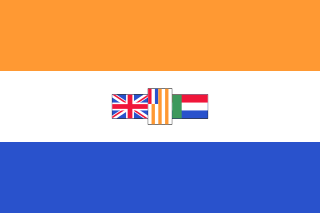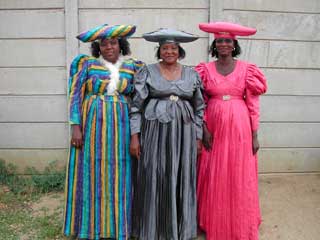Related Research Articles

South West Africa, renamed to Namibia from 12 June 1968 was a territory under South African administration from 1915 to 1990, after which it became modern-day Namibia. It bordered Angola, Botswana, South Africa, and Zambia. During its administration, South Africa applied its own apartheid system in the territory of South West Africa.
The history of Namibia has passed through several distinct stages from being colonised in the late nineteenth century to Namibia's independence on 21 March 1990.

A Bantustan was a territory that the National Party administration of South Africa set aside for black inhabitants of South Africa and South West Africa, as a part of its policy of apartheid.

Kaokoland was an administrative unit and a bantustan in northern South West Africa. Established in 1980 during the apartheid era, it was intended to be a self-governing homeland of the Ovahimba, but an actual government was never established, and the territory was administered by the leaders of Hereroland. Like other homelands in South West Africa, the Kaokoland bantustan was abolished in May 1989, at the beginning of the transition of Namibia towards independence.

The Herero are a Bantu ethnic group inhabiting parts of Southern Africa. There were an estimated 250,000 Herero people in Namibia in 2013. They speak Otjiherero, a Bantu language. Though the Herero primarily reside in Namibia, there are also significant populations in Botswana and Angola, and a small number in South Africa. The Hereros in Botswana and South Africa are there because of displacement during the 1904 - 1908 genocide committed by the German Empire.
Dirk Frederik Mudge was a Namibian politician. He served in several high-ranking positions in the South African administration of South West Africa, was the chairman of the 1975–1977 Turnhalle Constitutional Conference, and co-founded the Republican Party (RP) of Namibia as well as the Democratic Turnhalle Alliance (DTA), now known as the Popular Democratic Movement (PDM).

Hereroland was a bantustan and later a non-geographic ethnic-based second-tier authority, the Representative Authority of the Hereros, in South West Africa, intended by the apartheid-era government to be a self-governing homeland for the Herero people.

Tswanaland was a bantustan and then later a non-geographic ethnic-based second-tier authority, the Representative Authority of the Tswanas, in South West Africa, in the far central eastern area of the territory around the village of Aminuis. It was intended by the apartheid government to be a self-governing homeland for the Tswana people.

Kavangoland was a bantustan and then later a non-geographic ethnic-based second-tier authority, the Representative Authority of the Kavangos, in South West Africa, intended by the apartheid government to be a self-governing homeland for the Kavango people.

Maharero kaTjamuaha was one of the most powerful paramount chiefs of the Herero people in South-West Africa, today's Namibia.
Fanuel Jariretundu Kozonguizi was a Namibian lawyer and politician. He served as permanent petitioner to the United Nations on the issue of Namibian independence, and was a high-ranking administrator in South-West Africa prior to Namibian independence, both under South African administration and in the Transitional Government. In independent Namibia he was a member of Parliament and ombudsman. Kozonguizi was a founding member and first president of the South West African National Union.
Thimoteus Tjamuaha was the Chairman of the Executive Committee of Hereroland from 1980–1984, a bantustan under the control of Apartheid South Africa. In this position he was the highest representative of his homeland to the South African administration in South-West Africa.

Parliamentary elections were held in Namibia between 7 and 11 November 1989. These elections were for the Constituent Assembly of Namibia, which, upon independence in March 1990, became the National Assembly of Namibia.

The Turnhalle Constitutional Conference was a conference held in Windhoek between 1975 and 1977, tasked with the development of a constitution for a self-governed South West Africa (Namibia) under South African control. Sponsored by the South African government, the Turnhalle Conference laid the framework for the government of South West Africa from 1977 to independence in 1989.
Hoachanas is a settlement of 3,000 inhabitants in the Hardap Region of southern central Namibia, located 55 kilometres (34 mi) northeast of Kalkrand. It is situated at the junction of the main road C21 from Kalkrand, and C15 from Dordabis to Stampriet and belongs to the Mariental Rural electoral constituency.
Erastus Tjejamba was the Chairman of the Executive Committee of Hereroland from September 1984 to August 1987 and from October 1987 to February 1988. In this position he was the highest representative of his bantustan to the South African apartheid administration in South-West Africa.
Gottlob Hengombe Mbaukua was the Chairman of the Executive Committee of Hereroland from August 1987 to October 1987 and from February 1988 to May 1989. In this position he was the highest representative of his bantustan to the South African apartheid administration in South-West Africa. The Executive Committees were abolished in May 1989 as part of the transition to Namibian independence which was declared in March 1990.

Aminuis is a cluster of small settlements in the remote eastern part of the Omaheke Region of Namibia, located about 500 km east of Windhoek. It is the district capital of the Aminuis electoral constituency.
Vekuii Reinhard Rukoro was a Namibian lawyer, businessman, and Paramount Chief of the Herero people. He also served in Namibia's Parliament from 1989 to 2000 and, in Cabinet, as Attorney General of Namibia from 1995 to 2000. Rukoro died on 18 June 2021, of COVID-19.
Okamatapati is a settlement in the Otjozondjupa Region of Namibia, situated 100 kilometres (62 mi) south of Grootfontein and 127 kilometres (79 mi) north of Otjinene. The name Okamatapati is derived from Omutapati, the Otjiherero name for the Mouse-eared combretum, a shrub that is common in the area.
References
- 1 2 Namibian Homelands World Statesmen.org, accessed 15 June 2011